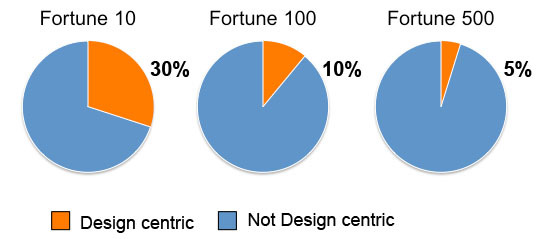Co-written by Finn Birger Lie
Large established organizations and small entrepreneurial ventures alike now understand that design is important to their business success. Could the next step be for these organizations to actually become design centric?
Now observed for over a decade, the returns of companies that focused on design and thus consistently won the International Design Excellence Award (previously the Industrial Design Excellence Award) out performed the S&P index by over six-and-a-half percent annually.
More recently, top tier Venture Capital firms in Silicon Valley are employing their own design partners to specifically help their portfolio companies build design centric organizations, leading them through a process towards great design.
However, what does it really mean to be design centric? Is it just the latest fad introduced by the business press without essentially defining the term? To shed some light on what actually is design centric, we invited creative professionals to share their views in the following challenge:
What does it mean to be "Design Centric?"
Established and startup companies alike know design can be an important competitive advantage, so, what does it actually take to be "Design Centric" in practice?
Here is a sample of what we discovered:
Design centric Leaders - Consider design a competitive advantage to be managed in-house. They master design strategy and context, as well as implementation and apply design strategically.
Design centric Culture - Design is directly linked to an empathetic business philosophy and the user experience is everything.
Design centric Structure - In the organizational chart, design is part of the C-suite. Design has a voice and brings a comprehensive approach that can challenge existing assumptions, encouraging adherents to think outside the box, ignore conventional limits and consider what might be possible.
Design centric Process - Design Thinking is incorporated as an inclusive part of a company's mind and work processes and focuses on framing the right opportunity instead of mere problem solving. They rely on design research to identify design opportunities and drive requirements, which is the core of design centric product development.
From these observations, we found the term design centric to be less understood than other more established terms, such as user centered, design thinking and design strategy. In general, the term design centric was suggested to be more of a combination of comprehensive design aspects like leadership, culture, structure and processes than the minute characteristics of the deliverables.
Some also raised concerns that framing design as centric would contradict the comprehensive approach needed to balance the needs and concerns of all relevant stakeholders, which should be at the center of any organization. Concerned that any type of centric, at all, whether it be user centric, technology centric, profit centric might eventually cause the loss of perspective and disintegrate into a dogma.
So, how then might we understand a term that has been taken on by parts of the business community as being the very "key" to achieving superior market value for S&P 500's and to securing competitive advantages and market growth for startups?
Design centric applied, in an empathetic business culture and comprehensive and inclusive design process, seems capable of driving both incremental or breakthrough innovation. Yet, all can agree that design is iterative and there is no natural conclusion to design. It is a constant learning, improving and testing cycle and, as such, lends itself best to process execution. Even so, design centric might just be the secret handshake that can finally "earn design a bonafide seat at the table."
Special thanks to Finn Birger Lie for researching and co-writing this article.
